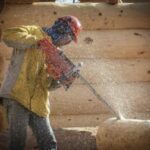As an Amazon Associate, this site earns commissions from qualifying purchases. For more information click here.
When we think of chainsaws, we imagine cutting hard, dry wood under the afternoon sun. But what if it rained and now the wood has gotten wet? Can you still cut it? Will that not damage the chainsaw? And what if it rains continuously? In this post we will answer the question if chainsaws can cut wet wood and if you can use it in the rain.
Wet wood will not damage chainsaws. In fact, the moisture lubricates the surface and makes cutting easier. However, sawdust sticks to the chain and can accumulate. You have to remove them to keep the cuts as smooth as possible.
Will Cutting Wet Wood Damage My Chainsaw?
Age and density determine how easy or hard wood will be to cut. Whether it is dry or wet is not a major factor. As pointed out earlier, the dampness can actually make cutting much smoother.

- A bit of moisture might help, but it boils down to the quality of the chainsaw and wood age. With a good blade, cutting wet wood will not require additional effort.
- One thing to keep in mind though. Sawdust or other debris will get on the blade. The exhaust and filter usually dispense sawdust, but that only works on dry wood.
So as you cut it may be necessary to remove sawdust from the chain. The dust will not prevent the chain from cutting, but too much can slow things down. However, removing dirt with a brush should fix it.
What Chain Should I Use to Cut Wet Wood?
A standard chainsaw chain will get the job done. A micro chisel chain is ideal for dense wood, but otherwise any high quality chain is fine. We like the Oregon 3-Pack AdanceCut because it works with Husqvarna, Wen, Poulan, Echo and other popular brands.
The simplest way to approach this is to treat wet wood as if it were dry. Doing this will make it easier to find out what chain works best for the task you want to accomplish.
First, decide what type of chain you will use. Chainsaw chains are not universal so if you have to get a replacement, make sure it is correct.
Next you apply mineral oil on the chain and cut through the wood. How hard or easy this will be depends on the type.
But ultimately it comes down to what type of wood you are cutting. Ironwood will always be harder to cut than balsa whether it is wet or dry. The same thing with green wood compared to dead wood.
Regardless which chain you use though, make sure that it is well oiled. Sure, wet wood functions as a natural lubricant, but mineral oil makes your chain rust and corrosion proof.
What is the Difference between Cutting Wet and Dry Wood?
Chainsaws cut through wet wood more easily because moisture reduces the friction between the wood fibers and chain cutter.
Density and age are the main factors that determine how hard the wood is to cut. But if you have the same wood (ironwood for instance) and one is wet the other dry, the wet one will be easier to work with.
The only drawback is the aforementioned sawdust buildup. If that happens, turn off the saw and remove the dust. It takes a lot of sawdust to slow a chainsaw down so no need to do this over and over.
What Chainsaw Type is Best for Cutting Wet Wood?
Gas powered chainsaws are the most suitable for rainy conditions and wet wood. You can use electric and battery powered chainsaws on wet wood, but do not use them in the rain or around tall, wet grass.
Professionals use gas powered chainsaws when it rains and you should too. As long as you keep the water out of the fuel tank there should be no problems. For all-purpose wood cutting, we suggest the Craftsman 41BY4216791 16″ chainsaw. It gets the job done without any fuss.
High quality chainsaws are built to withstand heavy downpour. They are specially designed to prevent water from leaking into the engine. But you can still encounter some problems so choosing the right chainsaw is a must.
First, do not leave your chainsaw in a pool of water. Never immerse the tool in water because water could seep into the engine and cause severe damage. If you are using gas powered chainsaws, do not allow water anywhere near the engine or tank.
Do not use electric chainsaws in the rain. Even if it has safety features, water and electricity can be dangerous If the electrical cords get wet the entire thing could short circuit and lead to serious damage. Not only will it wreck the chainsaw but you will be putting yourself at risk.
You can use battery powered chainsaws to cut wet wood. However, it is not a good idea to use it in the rain because water could leak into the battery.
Does Cutting Wet Wood Dull Chainsaw Blades?
Cutting wet wood does not dull chainsaw blades. However, if it is high density wood with a moisture level of over 20%, let the wood dry a little before cutting.
The easiest way to determine wood moisture level is to use a moisture meter. Using this you can get an accurate reading and know if it is all right to saw through the wood now or let it dry first.
It is true that wet wood is not likely to damage your chainsaw. But if the material is too wet, the chainsaw might vibrate and shake.
This is why it is important to use high quality chains. Wet wood and poor quality blades will make the process difficult.
If only the surface is wet, no problem. But if the entire wood is soaking, the blades could end up ripping through the wood fibers instead of cutting. This could create a mess.
If you need rough cuts then it is not a problem. But if you want a smooth finish, allow the wood to dry a little before proceeding.
Again you should know the wood density so you can get the right chainsaw for the job. Electrical or battery powered chainsaws are good for light to medium tasks, while gas powered models are best suited for heavy duty work.
For small branches and limbs, moisture will not be a problem. Any chainsaw should work and the moisture could actually speed up cutting.
Remember to apply oil or lubricant to the blade. Even though the wood is wet, adding extra lubricant will make cutting even smoother.
How to Prepare Wet Wood for Cutting
If the wood is light and only slightly wet, you can cut it right away. For wet green wood, allow it to dry first. Once dry, lubricate your chainsaw and start cutting.
If the wood is at its peak age wise, cutting will take more time. So if the wood is thick, fresh and wet, give it as much time as possible to dry. Sure, a powerful chainsaw can probably rip through it, but you could end up destroying the wood instead of just cutting.
While waiting for the wood to dry, lubricate the chain. Lubrication is essential to improve performance and prevent rust. Corrosion in particular can be an issue if you use the chainsaw on wet wood.
Do not use electric chainsaws in wet conditions. Electrical cords and extension cables should never be allowed to touch wet grass or moist surfaces. If the surrounding area is dry, then yes you can cut wet wood with an electric chainsaw.
You can use battery powered chainsaws on wet wood. Again you have to make sure water does not get into the battery to avoid problems.
Whether you are working with wet or dry wood, always wear protective gear. Rubber gloves, goggles, helmet and protective clothing are a must.
How to Clean a Wet Chainsaw
Cleaning and maintenance are essential to making your chainsaw last. Do the following and you should be able to cut through a lot of wet wood without problems.
- Remove sawdust before they accumulate. Because of the moisture, sawdust ends up on stuck on the chain.
- Wipe the chain brakes regularly. While you are it, always inspect the safety features of your saw before and after using it.
- Wipe water and debris off the sprocket. If water leaks through the chainsaw might stop running.
- Do not let water get inside the fuel tank.
- Clean the air filter, throttle trigger and clutch bearings regularly.
- If you are using an electric chainsaw, make sure the cords are intact.
Always inspect your chainsaw before and after use. If you notice something is off, examine it thoroughly and fix right away.

I love the outdoors and all the tools for maintaining gardens, yards and lawns. The only thing I am more passionate about is sharing what I know about garden and outdoor equipment.


